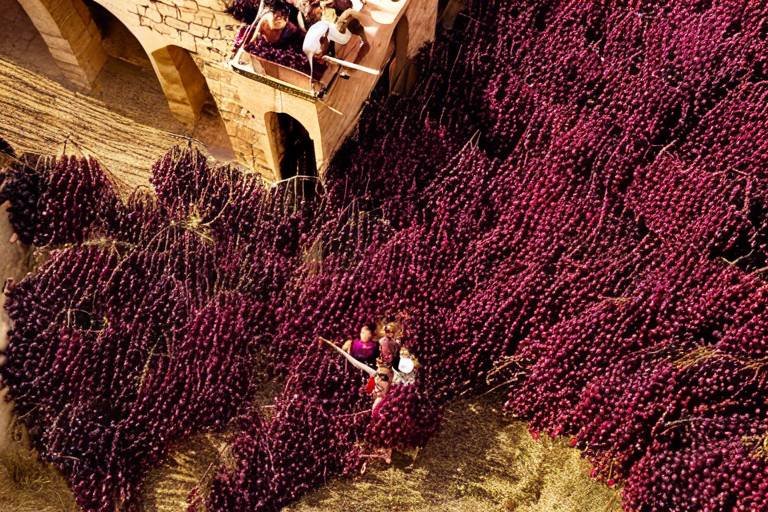India's Nag Panchami - The Festival of Snakes
India's Nag Panchami is a vibrant and intriguing festival deeply rooted in the cultural tapestry of the country. This ancient celebration, dedicated to honoring snakes, holds a unique place in the hearts of millions of Indians. The festival serves as a fascinating window into the rich mythology and traditions that have shaped the Indian subcontinent for centuries.
As the sun rises on the auspicious day of Nag Panchami, devotees across India come together to pay homage to these slithering creatures, which hold symbolic significance in Hindu mythology. Snakes are revered as symbols of fertility, protection, and divine energy, embodying both fear and reverence in the collective consciousness of the people.
One of the most captivating aspects of Nag Panchami is the elaborate rituals and practices that accompany the festival. From intricate snake worship ceremonies to the offering of prayers and milk to snake idols, every gesture is imbued with deep spiritual meaning. The air is filled with incense and the sound of hymns, creating an atmosphere of devotion and reverence.
Regional variations add a colorful dimension to the celebration, with each part of India infusing its unique customs and traditions into Nag Panchami. From the bustling streets of Mumbai to the serene villages of Kerala, the festival is a melting pot of diverse practices that reflect the cultural diversity of the country.
Delving into the symbolism of snakes in Indian culture unveils a tapestry of meanings woven through the fabric of mythology. These enigmatic creatures are not merely physical beings but representations of cosmic forces, embodying the eternal cycle of creation and destruction. In the intricate web of beliefs, snakes stand as guardians of hidden knowledge and protectors of the sacred.
While Nag Panchami has deep roots in ancient traditions, its significance in modern times continues to evolve. The festival now serves as a bridge between the past and the present, offering a glimpse into the enduring legacy of Indian spirituality and the adaptability of cultural practices in a changing world.
For Hindus, Nag Panchami holds a special place in religious observance, as it is a time to seek blessings from the serpent deity for the well-being of one's family and loved ones. The rituals performed during the festival are believed to bring prosperity, health, and protection from harm, fostering a sense of spiritual connection and community.
Mythological legends surrounding snakes abound in Hindu scriptures and epics, weaving tales of valor, deceit, and divine intervention. From the serpent king Vasuki to the multi-headed Adishesha, these mythical beings play pivotal roles in shaping the cosmic drama of creation and destruction, offering profound lessons in morality and destiny.
However, as the world grapples with environmental challenges, the ecological impact of Nag Panchami cannot be ignored. The festival's emphasis on snake worship raises important questions about the conservation of these reptiles and the delicate balance between cultural traditions and wildlife protection. Finding harmony between age-old practices and modern conservation efforts is crucial to preserving India's rich biodiversity.

History and Origins
Exploring the ancient Indian festival of Nag Panchami, dedicated to worshipping snakes as a symbol of fertility and protection. Learn about the traditions, rituals, and significance of this unique celebration.
Delving into the historical roots and cultural significance of Nag Panchami reveals a deep connection to Hindu mythology and ancient beliefs regarding snakes. In Indian culture, snakes are considered divine creatures, embodying various symbolic meanings related to fertility, protection, and divine energy. The festival of Nag Panchami celebrates these mystical beings through elaborate rituals and practices.

Celebration Practices
During Nag Panchami, the Festival of Snakes, celebration practices revolve around venerating these revered creatures in Hindu mythology. The central ritual involves snake worship, where individuals offer prayers and seek blessings from snakes for prosperity and protection. Devotees create elaborate snake idols or images, often made of silver or clay, and adorn them with flowers, milk, and incense as offerings. These rituals symbolize the reverence and gratitude towards snakes as divine entities.
One common practice during Nag Panchami is the act of carrying live snakes or images of snakes in processions through the streets. This public display of devotion showcases the significance of snakes in Indian culture and reinforces the belief in their protective powers. Additionally, individuals visit temples dedicated to snake deities, such as the Naga Devata, to offer special prayers and seek blessings for their families' well-being.
Another important aspect of the celebration is the belief in the spiritual significance of snakes as symbols of fertility and abundance. Many devotees observe fasts and perform special rituals to honor snakes and seek their blessings for prosperity in various aspects of life. The festival serves as a reminder of the interconnectedness between humans and nature, emphasizing harmony and respect for all living beings.

Regional Variations
When it comes to celebrating Nag Panchami, the diversity of regional variations across India adds a colorful tapestry to this ancient festival. In the southern state of Kerala, known for its rich cultural heritage, Nag Panchami takes on a unique charm with elaborate processions featuring serpent idols adorned with flowers and jewels. The vibrant festivities in Kerala symbolize the reverence for snakes as protectors of the land and guardians of fertility.
In the northern state of Rajasthan, Nag Panchami is celebrated with great fervor, reflecting the desert state's deep-rooted connection to nature. Here, snake charmers showcase their skill and bravery by handling venomous snakes as part of the traditional rituals. The sight of cobras swaying to the tunes of enchanting music captivates both locals and tourists, highlighting the mystical allure of Nag Panchami in Rajasthan.
Heading east to West Bengal, Nag Panchami takes on a spiritual essence intertwined with folklore and mythology. Devotees offer prayers to the serpent deity in temples adorned with intricate snake motifs, symbolizing the cycle of life and rebirth. The rhythmic beats of traditional drums echo through the air, creating a mystical ambiance that transports participants into a realm of ancient traditions and spiritual beliefs.
As we move westward to Maharashtra, Nag Panchami blends cultural traditions with a touch of modernity, reflecting the state's dynamic ethos. Here, colorful processions wind through the streets, accompanied by dancers in vibrant costumes depicting snake motifs. The fusion of traditional rituals with contemporary art forms showcases the evolving nature of Nag Panchami celebrations in Maharashtra, where ancient customs meet contemporary creativity.

Symbolism of Snakes
Exploring the ancient Indian festival of Nag Panchami, dedicated to worshipping snakes as a symbol of fertility and protection. Learn about the traditions, rituals, and significance of this unique celebration.
In Indian culture, snakes hold deep symbolism and significance, representing various aspects beyond their physical presence. Snakes are often associated with fertility, as they shed their skin, symbolizing rebirth and renewal. The image of a serpent is also linked to protection, guarding against evil forces and bringing prosperity to those who honor them.
Furthermore, in Hindu mythology, snakes are considered divine creatures, with the serpent god, Shesha, serving as a bed for Lord Vishnu. This association portrays snakes as embodiments of cosmic energy and power, highlighting their role in maintaining the balance of the universe.
Snakes are also seen as symbols of transformation and wisdom, as they navigate between the earthly realm and the underworld. Their ability to shed their skin represents the cyclical nature of life and the eternal cycle of birth and death.
Moreover, the coiled serpent, known as the Kundalini, is a spiritual symbol representing the dormant energy within individuals, waiting to be awakened through spiritual practices. This concept underscores the potential for inner transformation and enlightenment that snakes symbolize in Indian culture.

Modern Interpretations
Modern Interpretations of Nag Panchami hold a mirror to the evolving societal values and beliefs in contemporary India. While the festival's roots lie deep in ancient traditions, its significance has adapted to the changing times. Today, Nag Panchami is not only a religious event but also a cultural celebration that unites communities in reverence for nature and wildlife.
In the modern context, Nag Panchami serves as a reminder of the delicate balance between humans and nature. It encourages individuals to respect and protect all living beings, including snakes, which are often misunderstood and feared. The festival promotes environmental consciousness and the need to preserve biodiversity for future generations.
One of the modern interpretations of Nag Panchami is the emphasis on compassion and coexistence. As awareness about animal rights and conservation grows, the festival has become a platform to educate people about the importance of wildlife conservation and the role of snakes in maintaining ecological harmony.
Moreover, Nag Panchami in contemporary times is also viewed as a time for introspection and spiritual renewal. It prompts individuals to reflect on their relationship with nature and the interconnectedness of all living creatures. The rituals and prayers performed during the festival are seen as acts of gratitude towards the natural world.
Overall, the modern interpretations of Nag Panchami highlight the festival's enduring relevance in a rapidly changing world. By blending tradition with contemporary values, this ancient celebration continues to inspire reverence for nature and the preservation of cultural heritage.

Significance in Hinduism
In Hinduism, Nag Panchami holds immense religious significance as devotees pay homage to the serpent deity, Lord Shiva, and seek blessings for their families and loved ones. The festival symbolizes the worship of snakes as divine creatures and is deeply rooted in ancient Hindu mythology. Snakes are considered sacred beings in Hindu culture, representing fertility, protection, and divine energy.
During Nag Panchami, devotees offer prayers and milk to snake idols or live snakes, seeking their blessings for prosperity and well-being. The act of snake worship is believed to ward off evil and bring good fortune to the worshippers. It is a time for spiritual reflection and seeking divine blessings for the family's safety and prosperity.
According to Hindu beliefs, snakes are associated with various deities and play significant roles in mythological stories. The serpent deity, Nag Devata, is revered during Nag Panchami, and devotees seek protection from snake bites and other dangers associated with these creatures. The festival serves as a reminder of the interconnectedness between humans and nature, emphasizing the need for harmony and respect for all living beings.

Mythological Legends
Mythological Legends surrounding snakes hold a prominent place in Hindu mythology, with tales that depict these creatures as both revered and feared. One such legend revolves around the serpent Vasuki, used as a rope during the churning of the ocean to obtain the elixir of immortality. This story symbolizes the delicate balance between good and evil, highlighting the dual nature of snakes in Indian folklore.
Another popular mythological tale is the story of Lord Krishna subduing the venomous serpent Kaliya in the Yamuna River. This narrative showcases the power of divine intervention and the triumph of good over evil, emphasizing the significance of respecting and appeasing snakes in Hindu culture.
Furthermore, the ancient epic Mahabharata features the Naga clan, a race of semi-divine beings with serpent-like qualities. The story of Arjuna marrying Ulupi, a Naga princess, illustrates the intermingling of human and serpent worlds, symbolizing harmony and unity amidst diversity.

Ecological Impact
Nag Panchami, the ancient Indian festival dedicated to worshipping snakes, not only holds cultural and religious significance but also impacts the ecological balance in the region. As devotees across India pay homage to these revered creatures, there is a parallel concern for the conservation of snake populations and wildlife protection. The festival's rituals, which involve capturing snakes for worship, can have adverse effects on local ecosystems if not managed sustainably.
While Nag Panchami is deeply rooted in tradition and mythology, it is essential to consider its impact on the environment. The indiscriminate capture of snakes for religious purposes can disrupt the natural habitat and population dynamics of these reptiles. This practice poses a threat to the delicate balance of ecosystems and can lead to a decline in snake populations, affecting the overall biodiversity of the region.
Efforts are being made to raise awareness about the ecological impact of Nag Panchami and promote responsible practices during the festival. Conservationists and wildlife experts emphasize the need for sustainable ways to celebrate the festival without harming snake populations. Educating the public about the importance of preserving these creatures in their natural habitats is crucial for maintaining ecological harmony.
Conservation initiatives aim to protect snakes and their habitats by promoting coexistence between humans and wildlife. By fostering a deeper understanding of the ecological role of snakes and the importance of biodiversity conservation, these efforts seek to ensure the long-term survival of these fascinating creatures. Balancing cultural traditions with environmental conservation is key to safeguarding the ecological integrity of the regions where Nag Panchami is celebrated.
Frequently Asked Questions
- What is Nag Panchami?
Nag Panchami is an ancient Indian festival dedicated to worshipping snakes as symbols of fertility and protection. It is a day when snakes are revered and offerings are made to them to seek blessings for prosperity and well-being.
- When is Nag Panchami celebrated?
Nag Panchami falls on the fifth day of the bright half of the lunar month of Shravana according to the Hindu calendar, which usually corresponds to the months of July or August in the Gregorian calendar.
- What are the significance and symbolism of snakes in Indian culture?
In Indian culture, snakes symbolize fertility, protection, and divine energy. They are considered sacred beings in Hindu mythology and folklore, often associated with various deities and revered for their role in nature.
- How is Nag Panchami celebrated?
During Nag Panchami, devotees offer prayers to live snakes or images of snakes, perform rituals of snake worship, and seek blessings for their families. It is a day of reverence and devotion towards these creatures.
- Are there any regional variations in the celebration of Nag Panchami?
Yes, Nag Panchami is celebrated differently across various regions of India, with unique customs and traditions. Some regions have specific rituals associated with the festival, adding to the diversity of practices.



















